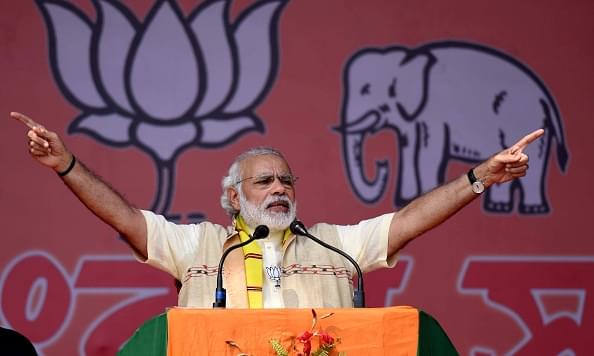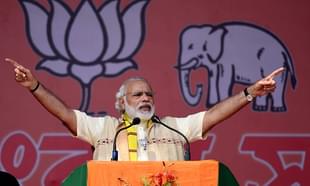Politics
How The BJP Is Steadily Growing In Assam
Maitreyee B Chowdhury
Apr 04, 2016, 03:40 PM | Updated 03:39 PM IST
Save & read from anywhere!
Bookmark stories for easy access on any device or the Swarajya app.


- In the last fifteen years and more, the Congress has lost its stronghold amongst the tea garden workers and given way to BJP and Asom Gana Parishad (AGP).
-
The role of the immigrant issue is larger than ever in this election, and the BJP and AGP have launched it as a strong election cause.
-
The identity crisis issue that has historically lingered over the many communities and dominant races of Assam has been effectively tapped by the BJP.
On 31 March, social media was abuzz with pictures of Rahul Gandhi’s visit to the picturesque little town of Digboi in upper Assam, where I was born. Gandhi’s visit to the township is well strategised since Digboi is nestled between the upper Assam tea gardens and natural reserve forest. Its workers traditionally form a large and important part of the electorate. Wooed by both the Congress and the BJP today, the tea garden workers play an important role in at least 35 of the 126 assembly seats.
As children we would often see the coolie workers (belonging to the Adivasi tribes) take prolonged leave to return to their villages near the tea gardens, where the air would be abuzz with the election fervour. These gentle folks often being the lifeline of our homes would be sorely missed during their absence and I remember asking them numerous questions about why it was so important for them to leave for the village at this time.
Nana, our man Friday would sit me down and tell me with a faraway look in his eyes, “Pakka ghor banai debe, notun kapod debe, Handiya khawar poisa o debe” (they will make permanent homes, new clothes and money for country liquor), and then he would laugh as I asked him, “Kake vote dibi, Nana?” (whom will you vote for?). He would raise his hand and say, “Haat ke dibo, aar kake dibo?” (I will vote for the hand, who else will I vote for?). The presence of any other party, or even the consciousness of an electoral process that could possibly involve some other party, seemed to be beyond the labourers.
History tells us that during the British rule and soon after, a rather large mass of Muslims had emigrated from undivided Bengal to Assam in search of work. This growth in immigrants (if one can call interstate traversing ‘immigration’) was because of multifold reasons, prime among which was the disinterest of the Assamese elite (owners of most of the tea estates since British India) to cultivate their own lands or find agreeable local equivalents to do the same. At this point, the import of labourers from central India, undivided Bengal and parts of Bihar seemed logical and even opportune – a trend further encouraged by the 1941 Land Settlement Policy.
In the last fifteen years and more, the Congress as a party has lost its stronghold among the tea garden workers, and given way to parties like BJP and Asom Gana Parishad (AGP) who over the years have sought to woo the garden workers, realising their important role in the elections. Meanwhile, the tea garden workers’ community, which has been fighting for the status of a Scheduled Tribe, now wants one of its own amongst the list of candidates.
I watched with great interest as people from different walks of life with access to social media put forward their own interpretations of Gandhi’s rally. In small towns in Assam where the presence of national level leaders is mostly rare, the presence of a Rahul Gandhi is something akin to a sightseeing option. The social media posts about Gandhi and my telephonic conversations with friends in the town made it clear that the reaction to the Congress leader was one more of amusement than of a serious political debate. It was very clear that Assam, like the rest of the country, was riding the BJP wave, and the Congress’ attempts at wooing the Muslim and tea garden community votes wasn’t going down very well with most people.
The immigrant issue which has played an important role in almost every election in Assam since independence is larger than ever in this election. The BJP along with the AGP has launched this as a strong election cause, promising action against illegal migration from Bangladesh – capitalising on the inherent fear within the Hindu Assamese populace about the once minority Muslim community becoming a larger player in Assam politics today, especially with the growing presence of the AIUDF as the second largest party in the state.
It must be noted at this point that both political parties do not count the tea garden workers as immigrants, in spite of the very obvious migrant history from undivided Bengal, states of Bihar and present day Jharkhand. In fact in 1979, at the height of the movement against the ‘outsiders’, the Assam Students’ Union (AASU) along with the All Assam Tea Tribes Students’ Union (ATTSA) declared in a joint statement that migrant tea workers in Assam had merged into the local society and were therefore an inseparable part of the Assamese community.
As I see social media making jokes about Gandhi’s offer of selling rice at Rs 2 per kg to the poor and the tea garden labourers, I reflect on how nothing has really changed since our childhood days of Congress rule in Assam, with political parties still doling out free or subsidized rice and local drink, as and when it matters to the poor, in the hopes of winning them over. And yet, the complete rout of the Congress in this state in evidence today can only be compared to the meteoric rise and tremendous fall of the AGP.
The rise of the BJP in Assam however proves to be an interesting case study for any political observer, especially keeping in mind the party’s characteristic traits of being able to adjust and blend into any given local scenario – to the extent that its leaders like chief ministerial candidate Sarbananda Sonowal has been fielded from Majuli, the nerve centre of Vaishnav monasteries in Assam. This, in spite of BJP’s Hindutva connections, forms an interesting political alliance that is not only far sighted (in the context of Assamese politics) but timely, considering the fact that the Satras throughout the state have constantly been threatened by land encroachment by immigrants from Bangladesh.
The identity crisis issue that has historically lingered over the many communities and dominant races of Assam has been effectively tapped by the BJP in Assam, with the realisation that the double edged sword of the immigrant issue and its recognition by a major national party would be a deal clincher for the community politics being played out here.
At this juncture, it would be important and interesting to note the reaction and stance of the Tai Ahom group (descendents of the Tai people, the indigenous Tibeto-Burmans) who in spite of the phase of Sanskritisation and Hindu links, have in recent years been constantly advocating a return to their original culture. This ‘return to the roots’ policy of the Tai Ahoms is hardly new and bears justification in the age-old rift between the Assamese Hindus and the Ahoms, in spite of the many moves made in the past to reconcile the Ahoms with the Hindu society (primarily Vaishnavites).
Any study of the growth of the BJP in Assam can never be complete without taking into account the increasing tensions in the many tribal parties – the skirmishes and uprisings throughout the state from time to time, as well as the grand fall of the AGP, which had in fact led the fight against the illegal immigrants into Assam.
The present election in Assam is poised to be one of the most important in its political history, not because of the rather prolific entry and exit of some big political players in the country, but because in many ways, it would decide the fate of the people of the state, who have been trying to propagate the idea of the construction of the Assamese into a composite society, which would help in arresting the already fragile state from dividing into more groups than ever.
In this regard the narratives of the different communities, their intermingling and interdependence need to be brought into focus, not only from the historical perspective but also as a focus of interest in the attempt at upholding the coming together and future development of a state that has been severely and since long been battered by terrorism, communal and language related wars.
Maitreyee B Chowdhury is a poet and writer based in Bangalore





